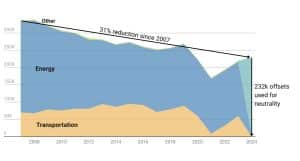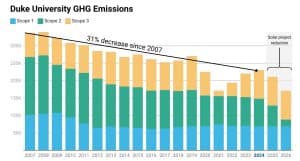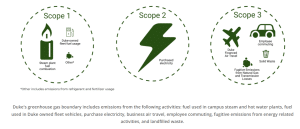Duke University achieved carbon neutrality in 2024, marking a significant milestone in its sustainability journey. However, achieving this status does not mean the university eliminated all its emissions.
Instead, it represents a strategic balance between reducing emissions and offsetting those that remain. In Duke’s case, this included a $4 million investment in carbon offsets to neutralize its greenhouse gas (GHG) emissions.
Duke’s Path to Carbon Neutrality: Balancing Reductions and Offsets
Duke University, under the American College and University Presidents’ Climate Commitment, pledged to achieve carbon neutrality across its emissions-generating activities. Its Climate Action Plan (CAP) categorizes emissions into three scopes:
Duke’s approach aligns with GHG accounting standards from the World Resources Institute, ensuring comprehensive tracking and reduction strategies for all emission sources. The university has significantly cut GHG emissions through various levers including:
- Eliminating coal use,
- Boosting building and utility efficiency, and
- Reducing commuting emissions.
Future reductions are planned through off-site solar investments and campus upgrades like steam-to-hot-water conversions and heat recovery chillers. Duke remains on track to achieve its 2030 emissions goals.
However, 2023 emissions rose 9% compared to 2022, primarily due to air travel nearing pre-pandemic levels. Despite this, energy-related emissions are down 41% since 2007, and 2023 levels remain 21% lower than in 2019.

Duke’s progress toward carbon neutrality began in 2007 when it launched an institution-wide effort to measure and reduce emissions. By fiscal year 2022, Duke had reduced its emissions by 43%, with plans to reach a 45% reduction by its 2024 deadline.

- However, emissions rose slightly, requiring Duke to offset nearly 69% of its 2007-level emissions instead of the planned 55%.
This reliance on carbon offsets underscores a critical reality: achieving net-zero emissions without offsets is nearly impossible for large institutions. Matthew Arsenault, Duke’s assistant director of carbon and sustainability operations, highlighted that:
“No institution, no company is going to be carbon neutral without using carbon offsets. There’s literally no way to reduce your emissions actually to zero.”
Carbon offsets provide a mechanism to balance emissions from essential activities, such as powering campus buildings and transportation. These activities, while minimized through efficiency measures, can only be partially eradicated.
How Carbon Offset Credits Work
Carbon offsets allow institutions to balance emissions by funding projects that either reduce GHG emissions or remove existing emissions from the atmosphere. Institutions like Duke use these tools to purchase carbon accounting units traded on carbon markets. These markets enable organizations to buy and sell surplus credits to meet their sustainability and net zero goals.
For Duke, offsets became a practical and ethical way to achieve carbon neutrality, given the current limitations of emission reduction technologies.
Carbon Offsets in Action: The Key to Duke’s Carbon Neutrality
Duke’s approach to carbon offsets has evolved over the years. In 2009, the university launched the Duke Carbon Offsets Initiative (DCOI), the first university-based program of its kind. This initiative focused initially on developing new offset projects, such as a methane-capture effort at a North Carolina hog farm, where methane was converted into usable electricity instead of being released into the atmosphere.
Other early projects included residential energy efficiency upgrades, urban tree plantings, and solar installations. These efforts were designed to both reduce GHG emissions and align with Duke’s broader sustainability values.
As the 2024 carbon neutrality deadline approached, Duke University shifted its strategy to focus on larger, externally sourced projects to meet its offset needs.
Almost 80% of Duke’s carbon offset portfolio consisted of projects targeting ozone-depleting refrigerants, which contain potent GHGs that can leak into the atmosphere. These projects, developed in collaboration with international partners, represented a significant step in reducing emissions from refrigerants.
The remaining offsets focused on methane capture from dairy farms and landfills, similar to Duke’s earlier hog farm project. By investing in these projects, Duke ensured its offsets addressed emissions effectively and sustainably.
Ensuring Quality and Accountability
Duke’s commitment to sustainability extends beyond simply purchasing offsets. The university employs a rigorous verification process to ensure the quality and ethical standards of its investments. This process involves collaboration with Ruby Canyon Environmental, a registered verifier on carbon markets, to vet prospective offset projects.
To guide decision-making, Duke developed a comprehensive evaluation tool that includes detailed questions about each project. Criteria such as “additionality” (ensuring the emissions reductions would not occur without the project) and “permanence” (long-term commitment to emissions reductions) are prioritized.
Projects that meet these standards are further reviewed by an advisory committee of faculty and students before purchase. Fewer than 10% of potential projects pass Duke’s initial evaluation, highlighting the university’s commitment to investing in high-impact and high-integrity carbon offsets.
What’s Next? Duke’s Plan Beyond Neutrality
While offsets played a key role in Duke’s 2024 achievement, the university recognizes the importance of continuing to reduce its emissions. Efforts are ongoing to expand energy efficiency measures on campus and integrate more renewable energy sources into operations.
Duke University’s carbon footprint will significantly decrease by mid-2025 when three off-campus solar facilities come online. They have a combined capacity of 101 megawatts. These projects will provide about 50% of the campus’s electricity and contribute renewable energy to North Carolina’s grid for decades.
Additionally, Duke is exploring ways to include its health system and international campuses, such as Duke Kunshan University, in future emissions tracking.
The university is now determining its “next-generation” climate goals, focusing on sustaining its carbon-neutral status and further reducing its offset dependency. This includes exploring innovative carbon offset projects, expanding renewable energy use, and encouraging campus-wide engagement in sustainability initiatives.
Carbon offsets will remain an essential tool in the university’s strategy, but Duke aims to rely on them less as it continues to refine its emissions reduction efforts. With its comprehensive approach and commitment to quality, Duke serves as a model for other institutions seeking to balance sustainability goals with the practical realities of carbon offsetting.



